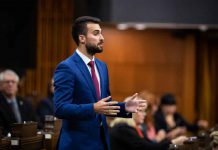Kenora – NEWS – Students and parents in Ontario can look forward to stronger math, STEM, and financial literacy curricula, a provincewide ban on cellphones in the classroom and improved skilled trades opportunities, as part of the Government of Ontario’s new vision for ‘Education that Works for You.’
“The previous government left us an outdated system that did not prepare our students for the realities of today,” said Greg Rickford, MPP, Kenora-Rainy River. ” We are going to be investing in education and students in a way that is focused on student achievement and well-being.”
The government’s plan, Education that Works for You, will protect a sustainable world-class education system for the students of today and the future and modernize the province’s classrooms and curriculum.
The province will ensure students are leaving school with the skills they need to build good lives, families and careers right here in Ontario while ensuring our education system is both fiscally sustainable and respectful of parents
“Shortly after we came to office we did what the previous government had been afraid to do – and threw the doors open to real, meaningful public and parental input into our education system,” said Thompson. “We heard from more than 72,000 parents, teachers, students, employers and organizations making this the largest consultation of its kind in Ontario history. The people told us what wasn’t working and what we need to protect.”
The new vision will modernize Ontario’s classrooms and provide students with more learning opportunities to prepare them for success in post-secondary education, apprenticeship and training, and the workforce.
The plan would include:
- Modernizing classrooms by expanding broadband, developing a new policy that will ban the use of cellphones during class except for educational purposes and modernizing the approach to assessment and evaluation with a renewed focus on equity across the province.
- Introducing changes to education funding that keep resources focused on students in the classroom.
- Supporting teacher mobility and bringing greater transparency, fairness, consistency and accountability to school board hiring practices of teachers.
- Maintaining class sizes for Kindergarten to Grade 3, establishing a consistent approach to class sizes for grades 4 to 8 and aligning secondary class sizes more closely with other Canadian jurisdictions, while introducing a new approach to e-learning and reducing pressure on school boards to put students in portables and split classes.
We’re also undertaking curriculum reform that will include:
- A new math curriculum that will focus on math fundamentals for all grades;
- A renewed focus on STEM, skilled trades and financial literacy; and
- A modern and age-appropriate Health and Physical Education curriculum that will keep students safe.
There will be clear provisions for parents who wish to exempt their child or children from sexual health education, and online modules will be available for parents who want to discuss sexual health topics at home whenever they feel their child is ready.
The government is committed to discussing the key elements of the proposed plan, including hiring practices and class sizes, through a consultation process that allows partners to provide the benefit of their expertise, experience and ideas.
“Our Government has been clear from the beginning that we are listening to parents and consulting with our education partners to modernize and improve Ontario’s education system from kindergarten to Grade 12,” said LOCAL MPP. “We welcome conversation with any stakeholder who wants to work with us in good faith to ensure our plan always puts students first and remains fair to our educators.”
Ontario’s Government for the People held the largest public consultation on education in the province’s history. The consultation included more than 72,000 engagements across three different consultation channels, which included an open submission form, online survey and telephone town halls held in every region of the province.
“Together we will build on a system that supports careers, promotes well-being and prepares every student for the future,” said Thompson.








